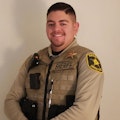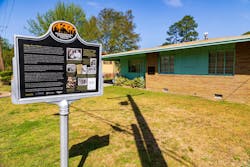How to Catch A Criminal: Fair & Impartial in the Case of Medgar Evers
Every officer with a decent amount of time on the job knows the unexpected turns an investigation can take. Seeing a major case through to completion often involves giving up on a theory and taking your investigation in a different direction as new information becomes available. In How to Catch A Criminal, we look at the many ways not-so-perfect crimes are solved. This month, a homicide case faces the challenges of a changing America.
This article appeared in the September/October issue of OFFICER Magazine. Click Here to subscribe to OFFICER Magazine.
As set forth in the Sixth Amendment, all Defendants are guaranteed a speedy public trial by an impartial jury. This process is of course designed to prevent a Defendant from being convicted due to prejudices of jury members, rather than the evidence presented during trial. By this logic, the Sixth Amendment should also prevent acquittal due to jurors prejudices against certain victims. At the end of the day, while it is up to each juror how much weight they place in testimony and evidence, it is also up to each juror to see past their personal beliefs.
In 1954 the U.S. Supreme Court ruled that racial segregation in schools was unconstitutional in the landmark Brown V. Board of Education of Topeka case. This decision was a pivotal moment for the civil rights movement, as well as a jumping off point in the lives of two diametrically opposed people. One in favor of desegregation, and the other in favor of keeping black students out of white schools.
Byron De La Beckwith, was 33 at the time the Brown V. Board of Education decision was handed down. He was living in Greenwood Mississippi and was a salesman by trade after serving in the Marine Corps during WWII. After the Supreme Court Decision in May of 1954, De La Beckwith, joined the White Citizen's Council, which formed just 2 months later. The WCC had the goal of preventing non-white students from attending traditionally white schools, which of course made the organization very attractive to De La Beckwith. As he became more active in furthering the ideals of white supremacy, Byron De La Beckwith joined the Ku Klux Klan.
On the other side of the activism coin, was Medgar Evers, who was 28 years old at the time school desegregation began. He was living in Mound Bayou, Mississippi and, like Byron De La Beckwith, he worked as a salesman for a living, after serving in the Army during WWII. Evers was honorably discharged as a sergeant and earned a Bachelor of Arts degree from Alcorn Agricultural and Mechanical College. Evers became President of the Regional Council of Negro Leadership. The RCNL was focused on ensuring black students would be able to attend public schools. Evers also decided to act as a test case for the Supreme Court ruling by attempting to enroll in the University of Mississippi School of Law, which historically did not accept black students. This led to Evers becoming a field secretary for the NAACP.
Being a prominent figure in the civil rights movement proved to be hazardous to one's health, especially in Mississippi. In 1955 civil rights leaders, George W. Lee and Lamar Smith were shot dead in the towns of Midnight and Brookhaven, respectively . In 1961 Herbert Lee was killed in Liberty. In 1964, Louis Allen, James Chaney, Andrew Goodman, and Michael Schwerner were all killed in various parts of Mississippi, and the latter three men were victims of the Ku Klux Klan. 1963, saw but one civil rights leader killed in Mississippi. Unfortunately that victim, was Medgar Evers.
By 1963, Medgar Evers had moved his family to the suburbs of Jackson Mississippi. Evers and his family were well aware of the target on his back thanks to his very public support of desegregation and justice for victims of racially motivated murders. In the weeks leading up to his assassination, Evers' home was nearly burned down when a Molotov cocktail was thrown into his carport, and he narrowly avoided being run over when a car swerved towards him as he left the local NAACP office. These attempts were blatant and clearly wouldn't stop until Evers was dead. Medgar knew this, but he was not willing to give up the fight for civil rights, even if it placed him in mortal danger. In the early hours of June 12, 1963, Medgar Evers was returning home after attending an NAACP meeting. He pulled into his driveway, and exited the car and headed to the front door. Before he could make it, Evers was shot in the back, through the heart, by a .30 caliber rifle. He managed to stumble to his front door before collapsing. His wife ran to the door after hearing the gunshot and rushed him to the hospital. He was pronounced dead in the hospital about an hour later.
Jackson Police swarmed the area and located the .30 caliber rifle on a nearby hill. Apparently, the shooter left in such a rush he forgot to bring his weapon. The rifle was checked for fingerprints and a lifted print was sent to the FBI for comparison. Given the likely racial motivation for the murder, the fingerprint was compared to those of known white supremacists in the area. This resulted in Byron De La Beckwith becoming the lead suspect. It was discovered that in the days leading up to Ever's murder, De La Beckwith had been asking locals where Evers lived. When investigators located Byron, they found he had a black eye, seemingly caused by the gun's recoil smashing the rifle's scope into his eye socket. With the intent, motive, and means of the crime established, Byron De La Beckwith was formally charged with the murder of Medgar Evers. Despite compelling evidence and testimony, the jury was unable to reach a verdict in February 1964, and a mistrial was declared. The same thing happened again in April of 1964. Unfortunately at the time of the murder, Mississippi jury duty was assigned to registered voters, and voting laws of the time excluded black citizens. This meant the juries in both trials were all-white. However, since there wasn't a “not guilty” verdict, the case could be retried without violating De La Beckwith's right against double jeopardy.
In February of 1994, 30 years after the first mistrial, De La Beckwith was on trial again at the age of 73. Evers' widow had pushed for the case to be reopened, and with the time that had gone by, new evidence had come to light. When the FBI began looking into the case again, they found some of Byron's former Klan cohorts were now willing to talk. These witnesses testified that after the shooting, De La Beckwith wasted no time bragging to everyone who would listen that he was the man who killed Medgar Evers. This time, a racially diverse jury found him guilty, and he was sentenced to life in prison. He would complete his sentence January of 2001, when he passed away due to natural causes.
About the Author

Officer Brendan Rodela, Contributing Editor
Brendan Rodela is a Sergeant for the Lincoln County (NM) Sheriff's Office. He holds a degree in Criminal Justice and is a certified instructor with specialized training in Domestic Violence and Interactions with Persons with Mental Impairments.

